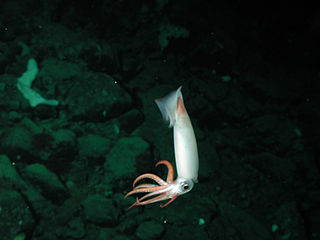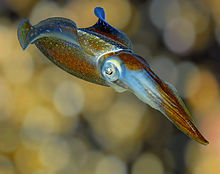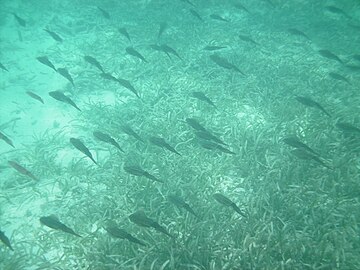
An octopus is a soft-bodied, eight-limbed mollusc of the order Octopoda. The order consists of some 300 species and is grouped within the class Cephalopoda with squids, cuttlefish, and nautiloids. Like other cephalopods, an octopus is bilaterally symmetric with two eyes and a beaked mouth at the center point of the eight limbs. The soft body can radically alter its shape, enabling octopuses to squeeze through small gaps. They trail their eight appendages behind them as they swim. The siphon is used both for respiration and for locomotion, by expelling a jet of water. Octopuses have a complex nervous system and excellent sight, and are among the most intelligent and behaviourally diverse of all invertebrates.

A squid is a mollusc with an elongated soft body, large eyes, eight arms, and two tentacles in the superorder Decapodiformes, though many other molluscs within the broader Neocoleoidea are also called squid despite not strictly fitting these criteria. Like all other cephalopods, squid have a distinct head, bilateral symmetry, and a mantle. They are mainly soft-bodied, like octopuses, but have a small internal skeleton in the form of a rod-like gladius or pen, made of chitin.

A cephalopod is any member of the molluscan class Cephalopoda such as a squid, octopus, cuttlefish, or nautilus. These exclusively marine animals are characterized by bilateral body symmetry, a prominent head, and a set of arms or tentacles modified from the primitive molluscan foot. Fishers sometimes call cephalopods "inkfish", referring to their common ability to squirt ink. The study of cephalopods is a branch of malacology known as teuthology.

The California two-spot octopus, often simply called a "bimac", is an octopus species native to many parts of the Pacific Ocean including the coast of California. One can identify the species by the circular blue eyespots on each side of its head. Bimacs usually live to be about two years old. They are closely related to Verrill's two-spot octopus. In 2015, the genome was sequenced.

Cephalopod intelligence is a measure of the cognitive ability of the cephalopod class of molluscs.

The paintpot cuttlefish is a small, poorly researched species of cuttlefish found in the Indo-Pacific, between Japan and Hong Kong. It is one of the two species classified in the genus Metasepia. Metasepia cuttlefish are characterized by their small, thick, diamond-shaped cuttlebone, and distinctive body coloration.

The common cuttlefish or European common cuttlefish is one of the largest and best-known cuttlefish species. They are a migratory species that spend the summer and spring inshore for spawning and then move to depths of 100–200 metres (330–660 ft) during autumn and winter. They grow to 49 centimetres (19 in) in mantle length and 4 kilograms (8.8 lb) in weight. Animals from subtropical seas are smaller and rarely exceed 30 centimetres (12 in) in mantle length.

The pharaoh cuttlefish is a large cuttlefish species, growing to 42 cm in mantle length and 5 kg in weight.

Sepia mestus, also known as the reaper cuttlefish or red cuttlefish, is a species of cuttlefish native to the southwestern Pacific Ocean, specifically Escape Reef off Queensland to Murrays Beach off Jervis Bay. Reports of this species from China and Vietnam are now known to be misidentifications. S. mestus lives at a depth of between 0 and 22 m.

The Gonatus onyx is in the class Cephalopoda, in the phylum Mollusca. It is also known as the Clawed arm hook squid or the Black-eyed squid. It got these names from the characteristic black eye and from its two arms with clawed hooks on the end that extend a bit further than the other arms. It is a squid in the family Gonatidae, found most commonly in the northern Pacific Ocean from Japan to California. They are one of the most abundant cephalopods off the coast of California, mostly found at deeper depths, rising during the day most likely to feed.

Cuttlefish, or cuttles, are marine molluscs of the order Sepiida. They belong to the class Cephalopoda which also includes squid, octopuses, and nautiluses. Cuttlefish have a unique internal shell, the cuttlebone, which is used for control of buoyancy.

Sepioteuthis, commonly known as reef squids or oval squids, is a genus of pencil squid. Reef squids are easily recognizable by their large rounded fins that extend along almost the entire length of their mantles, giving them a superficial resemblance to cuttlefish.

Sepioteuthis lessoniana, commonly known as the bigfin reef squid, glitter squid or oval squid, is a species of loliginid squid. It is one of the three currently recognized species belonging to the genus Sepioteuthis. Studies in 1993, however, have indicated that bigfin reef squids may comprise a cryptic species complex. The species is likely to include several very similar and closely related species.

Sepiella inermis is a species of cuttlefish in the family Sepiidae. S. inermis is indigenous to the Indo-Pacific region. In this region, Sepiella inermis is an economically important species, and is sold and eaten.
Sepia trygonina, the trident cuttlefish, is a species of cuttlefish in the genus Sepia from the Red Sea and the western Indian Ocean. They are also a major source of food for larger marine life like dolphins, seals, and even birds.

Euprymna berryi, commonly called hummingbird bobtail squid or Berry's bobtail squid among various other vernacular names, is a species of mollusc cephalopod in the family Sepiolidae.

Sepioteuthis australis, commonly known as the southern calamari or the southern reef squid, is a species of reef squid that is native to oceans off the coast of Australia and New Zealand. This species is caught commercially by trawling, as bycatch in the prawn fishing industry and by recreational anglers.

Sepioloidea lineolata or more commonly known as the striped pyjama squid or the striped dumpling squid is a type of bottletail squid that inhabits the Indo-Pacific Oceans of Australia. Although traditionally falling within Sepiida, the cuttlefish order, it lacks a cuttlebone. More recent phylogenomic evidence suggests bottletail and bobtail squid may form their own order, Sepiolida. The striped pyjama squid lives on the seafloor and is both venomous and poisonous. When fully mature, a striped pyjama squid will only be about 7 to 8 centimetres in length. Baby striped pyjama squid can be smaller than 10 millimetres (0.39 in).

The dwarf cuttlefish (Sepia bandensis), also known as the stumpy-spined cuttlefish, is a species of cuttlefish native to the shallow coastal waters of the Central Indo-Pacific. The holotype of the species was collected from Banda Neira, Indonesia. It is common in coral reef and sandy coast habitats, usually in association with sea cucumbers and sea stars. Sepia baxteri and Sepia bartletti are possible synonyms.

Wunderpus photogenicus, the wunderpus octopus, is a small-bodied species of octopus with distinct white and rusty brown coloration. 'Wunderpus' from German “wunder” meaning ‘marvel or wonder’.
























